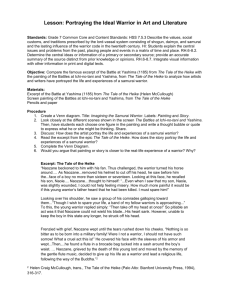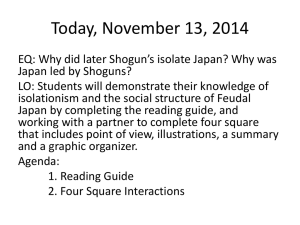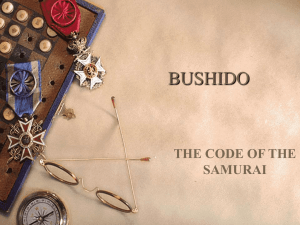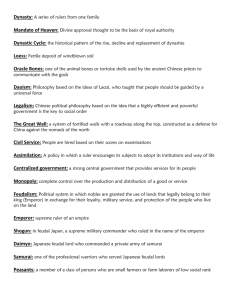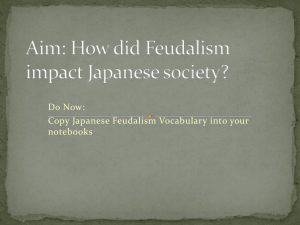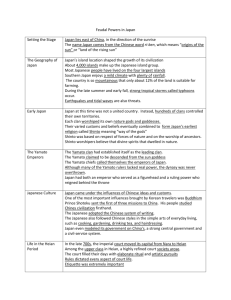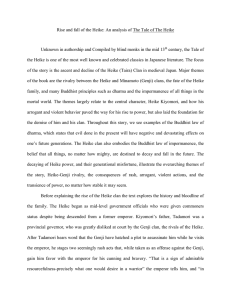Lesson: Comparing Perspectives ()
advertisement
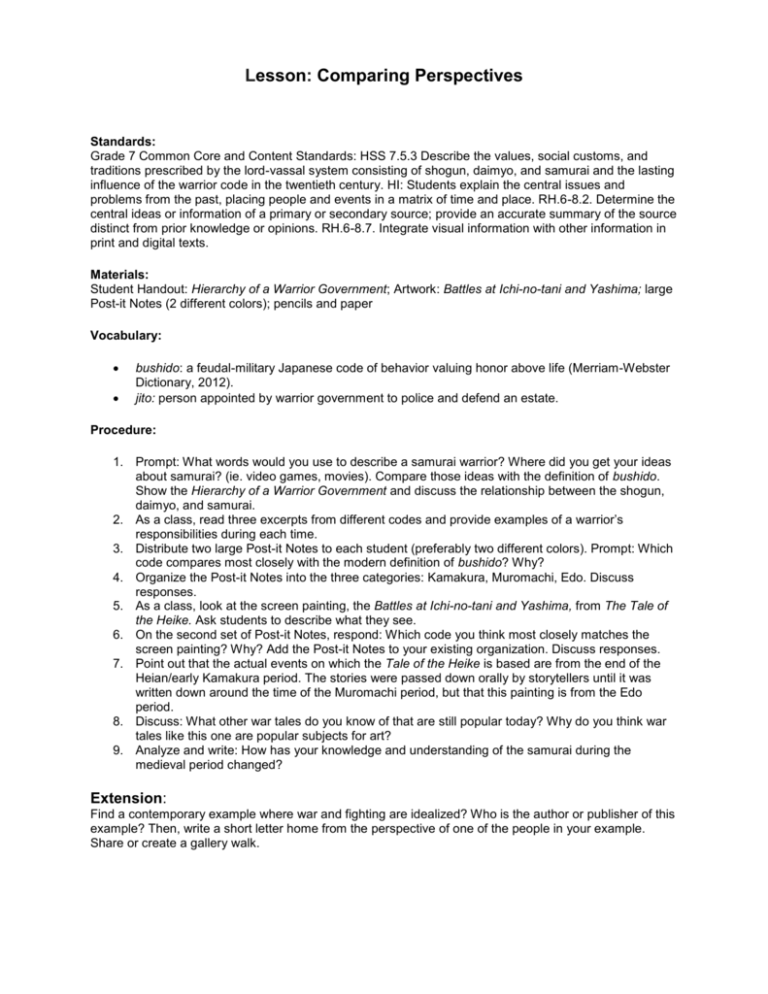
Lesson: Comparing Perspectives Standards: Grade 7 Common Core and Content Standards: HSS 7.5.3 Describe the values, social customs, and traditions prescribed by the lord-vassal system consisting of shogun, daimyo, and samurai and the lasting influence of the warrior code in the twentieth century. HI: Students explain the central issues and problems from the past, placing people and events in a matrix of time and place. RH.6-8.2. Determine the central ideas or information of a primary or secondary source; provide an accurate summary of the source distinct from prior knowledge or opinions. RH.6-8.7. Integrate visual information with other information in print and digital texts. Materials: Student Handout: Hierarchy of a Warrior Government; Artwork: Battles at Ichi-no-tani and Yashima; large Post-it Notes (2 different colors); pencils and paper Vocabulary: bushido: a feudal-military Japanese code of behavior valuing honor above life (Merriam-Webster Dictionary, 2012). jito: person appointed by warrior government to police and defend an estate. Procedure: 1. Prompt: What words would you use to describe a samurai warrior? Where did you get your ideas about samurai? (ie. video games, movies). Compare those ideas with the definition of bushido. Show the Hierarchy of a Warrior Government and discuss the relationship between the shogun, daimyo, and samurai. 2. As a class, read three excerpts from different codes and provide examples of a warrior’s responsibilities during each time. 3. Distribute two large Post-it Notes to each student (preferably two different colors). Prompt: Which code compares most closely with the modern definition of bushido? Why? 4. Organize the Post-it Notes into the three categories: Kamakura, Muromachi, Edo. Discuss responses. 5. As a class, look at the screen painting, the Battles at Ichi-no-tani and Yashima, from The Tale of the Heike. Ask students to describe what they see. 6. On the second set of Post-it Notes, respond: Which code you think most closely matches the screen painting? Why? Add the Post-it Notes to your existing organization. Discuss responses. 7. Point out that the actual events on which the Tale of the Heike is based are from the end of the Heian/early Kamakura period. The stories were passed down orally by storytellers until it was written down around the time of the Muromachi period, but that this painting is from the Edo period. 8. Discuss: What other war tales do you know of that are still popular today? Why do you think war tales like this one are popular subjects for art? 9. Analyze and write: How has your knowledge and understanding of the samurai during the medieval period changed? Extension: Find a contemporary example where war and fighting are idealized? Who is the author or publisher of this example? Then, write a short letter home from the perspective of one of the people in your example. Share or create a gallery walk. Background Information Samurai: Real and Imagined The life and persona of the samurai are alive in popular imagination, but how well do they reflect historical accuracy? By comparing representations of the samurai in medieval Japan through art and literature, consider how our understanding of warrior culture compares to the reality of their daily lives. Samurai (lit. “one who serves”) refers to members of Japan’s warrior class. The origins of the samurai can be traced to the eighth and ninth centuries, when large landholdings moved into the hands of the imperial family and related members of the aristocracy. In the Heian period (794–1185), the Kyoto-based imperial court and nobles depended on the agricultural income from these landholdings, especially large private estates in northern Japan. The need to defend these distant estates from attacks by local chieftains led to the birth of the samurai. Nobles sent from the capital to govern the estates often lacked the skills and authority necessary to maintain security or provide effective administration in such remote districts, so the court appointed deputies from among the local population to assist them. Forerunners of the samurai, these deputies built local and regional power by creating privately controlled militias, called “warrior bands.” Starting as little more than family organizations, warrior bands were initially formed for the duration of a military campaign. Afterward, the group was disbanded to allow the men to return to farming. By the eleventh century the bands were changing to groups of fighting men not necessarily connected through kinship. Power was beginning to aggregate in the hands of a few elite military families, or clans, whose regional dominance was supported by the fighting abilities of retainers and vassals. These were men bound to their lords by vows of loyalty and/or other contractual obligations, such as grants of land or income in exchange for military service. The Genpei War and First Warrior Government By the late eleventh century, the Minamoto (also known as Genji) clan was recognized as the most powerful in the northeastern region of Japan, having defeated several other strong local groups. In the mid-twelfth century, the Minamoto clashed with the mighty Taira (also known as Heike) clan, which controlled an important western region including the area around Kyoto. A series of engagements, culminating in the Genpei War (1184–1185), ended with the defeat of the Taira. The victorious Minamoto went on to establish a new, warrior-led government at Kamakura, their eastern stronghold. In 1185 the great Minamoto leader Minamoto Yoritomo (1147–1199) was appointed shogun by the emperor. Yoritomo established a military government (bakufu) appointing warriors to fill important regional posts as constables or military governors and land stewards. Reporting to the shogun were daimyo—provincial landowners who led bands of warrior vassals and administered the major domains. From the thirteenth century on, Japan was ruled through a dual government structure. While the emperor retained cultural and religious sovereignty over the nation, the military elite during this period assumed political and economic leadership. This system of governance remained until the late 1800s. The Tale of the Heike At the end of the Heian period (794–1185), two warrior clans, the Minamoto (Genji) and the Taira (Heike) fought for control of Japan in the Genpei War. The rivalries of the two clans are described in the historical epic The Tale of the Heike. “The sound of the Gion Shōja bells echoes the impermanence of all things; the color of the sāla flowers reveals the truth that the prosperous must decline. The proud do not endure, they are like a dream on a spring night; the mighty fall at last, they are as dust before the wind.”1 As the story opens, the Taira maintain power over the imperial throne under the leadership of Taira no Kiyomori. Facing shifting alliances, Kiyomori begins to act with ruthlessness, creating enemies in the process. In the beginning, the narrator tells how Kiyomori’s actions transgress the boundaries of honorable conduct. This section ends as Kiyomori, wracked by disease and fever, succumbs to a terrible illness. The second and third sections recount the struggle, intrigue, and finally the civil wars that ensued between the Minamoto and Taira clans after Kiyomori’s death. The tale ends with the total devastation of the Taira and the supremacy of the Minamoto, led by Minamoto Yoritomo. The value of the Heike lies not only in its character as historical narrative describing battles and political intrigues but also in its lessons about samurai daily life, etiquette, and ethical values informed by the Buddhist belief in the impermanence of worldly phenomena. Itinerant singers transmitted the war tales orally, spreading stories of warriors’ loyalty, courage, and virtue throughout the country. The scene depicted on this folding screen may be regarded as presenting an ideal version of the samurai code of conduct, or bushido. By illustrating the desirable aspects of warrior behavior in an entertaining form, the artist helped to promote these principles in an era, the Edo period (1615–1886), approximately five hundred years after The Tale of the Heike was written, when samurai were not often called upon to use their weapons. 4
